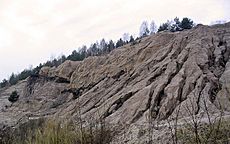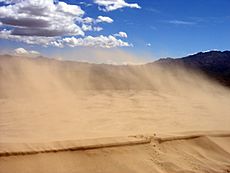Erosion facts for kids
Erosion is a process where natural forces like water, wind, ice, and gravity wear away rocks and soil. It is a geological process, and part of the rock cycle. Erosion occurs at the Earth's surface, and has no effect on the Earth's mantle and core.
Most of the energy that makes erosion happen is provided by the Sun. The Sun's energy causes the movement of water and ice in the water cycle and the movement of air to create wind.
Erosion can cause problems that affect humans. Soil erosion, for example, can create problems for farmers. Soil erosion can remove soil, leaving a thin layer or rocky soil behind. Erosion can also cause problems for humans by removing rocks or soil that support buildings.
Contents
Erosion by water
Temperature changes cause pieces of rock to flake away from the surface. Also, the acid in rainwater dissolves rocks containing calcium carbonate. These processes are called weathering.
Water erosion happens when water moves the pieces of rock or soil downhill. Waves also carry away small pieces of material. A wave can wash up onto the surface of rock or soil and then carry away pieces of material as it flows back into the ocean or lake.
The size of earth materials that can be moved by water depends on how fast the water is moving. A fast-flowing stream can carry large rocks while a slow moving stream might only be able to carry very small things like clay. Canyons, like the Grand Canyon, are among the most obvious features made by erosion. Where a river meets the sea, it drops the solids, sometimes making a river delta.
Tropical rivers

Large tropical rivers like the Paraná, Indus, Brahmaputra, Ganges, Zambezi, Mississippi and the Amazon carry huge amounts of sediment down to the sea. The Nile, perhaps the world's longest river, carries much less sediment than the others because, part of the way, it runs through less fertile regions than the other great rivers.
The Amazon has by far the largest waterflow, with an average discharge greater than the next seven largest rivers combined. It has the largest drainage basin in the world, about 7,050,000 square kilometres (2,720,000 sq mi). The Amazon accounts for about one-fifth of the world's total river flow.
The sediment discharged by the gigantic mouth of the Amazon stains the sea brown for hundreds of miles out to sea.
Erosion by ice
Ice erosion happens when a glacier moves downhill. As the ice of the glacier moves downhill, it pushes and pulls earth materials along with it. Glaciers can move very large rocks. Ice erosion can happen in another way. Cold weather causes water inside tiny cracks in rocks to freeze. As it freezes, the ice gets bigger, and pushes hard against the rock. This can break the rock.
Erosion by wind
Wind erosion occurs when wind moves pieces of earth materials. Wind erosion is one of the weakest kinds of erosion. Small pieces of earth material can be rolled along the ground surface by wind. Very small pieces can be picked up and carried by the wind. Sometimes, wind can carry small pieces of earth materials over large distances. Some sediment from the Sahara Desert is carried across the Atlantic Ocean by wind.
One of the most famous examples of wind erosion occurred in the Dust Bowl, when wind erosion severely damaged farming communities.
Erosion by gravity
Gravity erosion is the simplest kind of erosion. Gravity simply pulls loose earth materials downhill. Landslides are dramatic examples of gravity erosion.
Erosion and tectonics
Tectonic effects on erosion has long been recognized. For example, rivers form as a result of tectonic uplift (as Himalayas and Tibetan Plateau). All of the Earth's mountain ranges were created by the upward movement of the land by changes beneath the Earth's surface. When the ground rises the whole weather system can also be changed including local sea levels, wind strength and direction, rainfall and more.
The Earth's landscape is a product of two factors. Tectonics builds up height by surface and rock uplift, and climate controls the erosion. Erosion wears away upland areas over time. The interaction of these processes can form, modify, or destroy features of the Earth’s surface.
Images for kids
-
An actively eroding rill on an intensively-farmed field in eastern Germany
-
A natural arch produced by the wind erosion of differentially weathered rock in Jebel Kharaz, Jordan
-
A wave-like sea cliff produced by coastal erosion, in Jinshitan Coastal National Geopark, Dalian, Liaoning Province, China
-
Soil and water being splashed by the impact of a single raindrop
-
A spoil tip covered in rills and gullies due to erosion processes caused by rainfall: Rummu, Estonia
-
Dobbingstone Burn, Scotland, showing two different types of erosion affecting the same place. Valley erosion is occurring due to the flow of the stream, and the boulders and stones (and much of the soil) that are lying on the stream's banks are glacial till that was left behind as ice age glaciers flowed over the terrain.
-
Layers of chalk exposed by a river eroding through them
-
Erosion of the boulder clay (of Pleistocene age) along cliffs of Filey Bay, Yorkshire, England
-
The Devil's Nest (Pirunpesä), the deepest ground erosion in Europe, located in Jalasjärvi, Kurikka, Finland
-
Glacial moraines above Lake Louise, in Alberta, Canada
-
A wadi in Makhtesh Ramon, Israel, showing gravity collapse erosion on its banks
See also
 In Spanish: Erosión para niños
In Spanish: Erosión para niños

















